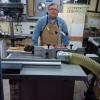In the other recent thread around table saw accidents, I asked what specific activities people are doing on their table saws that put their fingers close to the blades in the first place... but that thread has (predictably) turned into a discussion of whether SS is worth it or not etc. so I'm starting a separate thread.
THIS THREAD IS NOT ABOUT SAW STOP
I would like to know points of view on how to safely use a table saw. I think if these rules (and others that you'll hopefully add) are followed, risk of injury is greatly reduced. I'd like to know the safest approach.
These are paraphrased from what I was taught at woodworking course (Lohr):
Be alert, not tired, obviously no alcohol
Clean/safe working environment (no clutter, no piles of sawdust etc.)
Plan your cuts, think through them ahead of time
Proper lumber preparation ahead of cutting, especially if cutting against a fence (i.e. you need a straight reference edge)
Don't cut short pieces against the fence (piece should be able to reach from before the blade to the splitter)
Blade raised high enough (I was taught a little "too-high" is far better than too low... pushes wood down instead of at you)
Splitter or riving knife for all possible cuts
Guard in place for all possible cuts
Properly aligned fence
Left hand (guide hand) never goes past the front edge of the table
Right hand uses a well-designed push tool as soon as it passes the front of table
What other safety rules do you follow that I should incorporate into my routine?
And, do you think that following these protocols greatly reduces risk of injury? (i.e. as safe as: using a snow blower or lawn mower, trimming hedges, using a paper cutter at work, riding a bike off trail, rock climbing with a harness, playing 2-hand touch football, throwing darts, cutting fabric with shears, sewing with a sharp needle, re-winding a torsion spring on garage door, cleaning gutters on the 2nd story, using your knee to steer the car for a brief moment....)





 Reply With Quote
Reply With Quote




